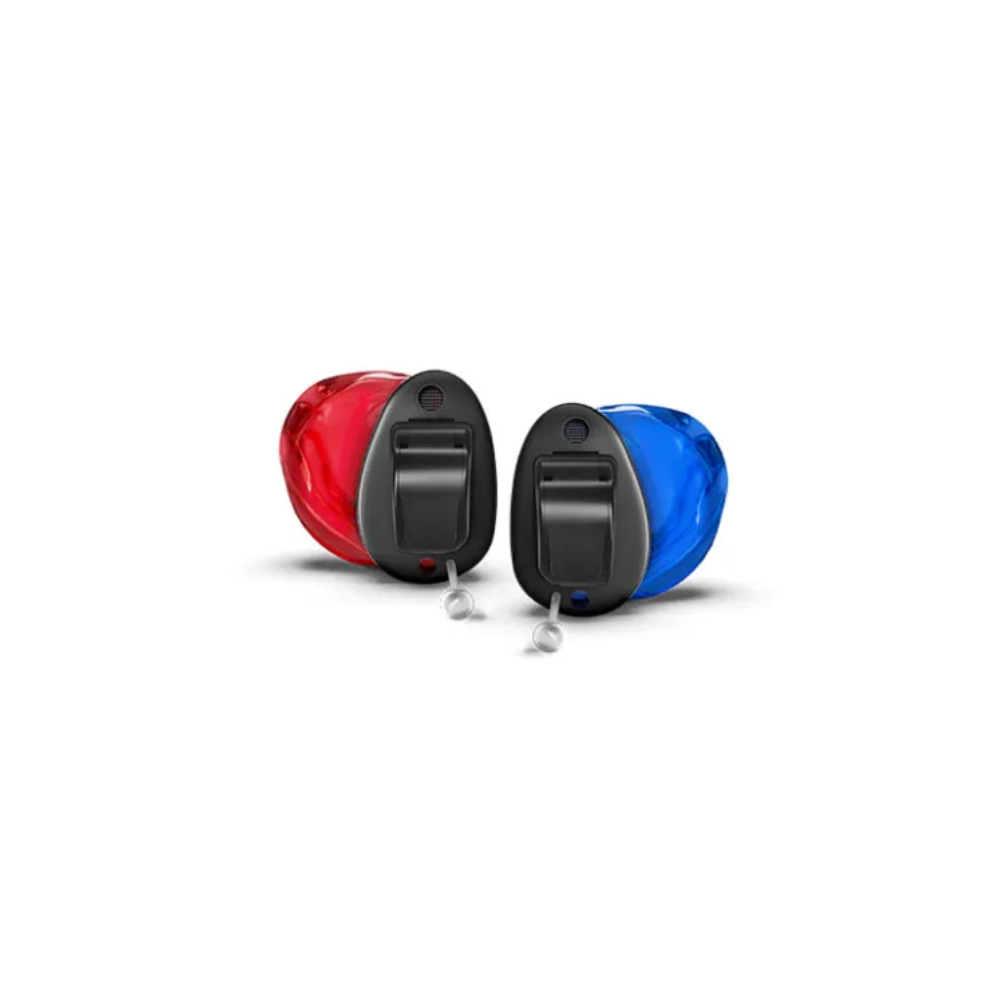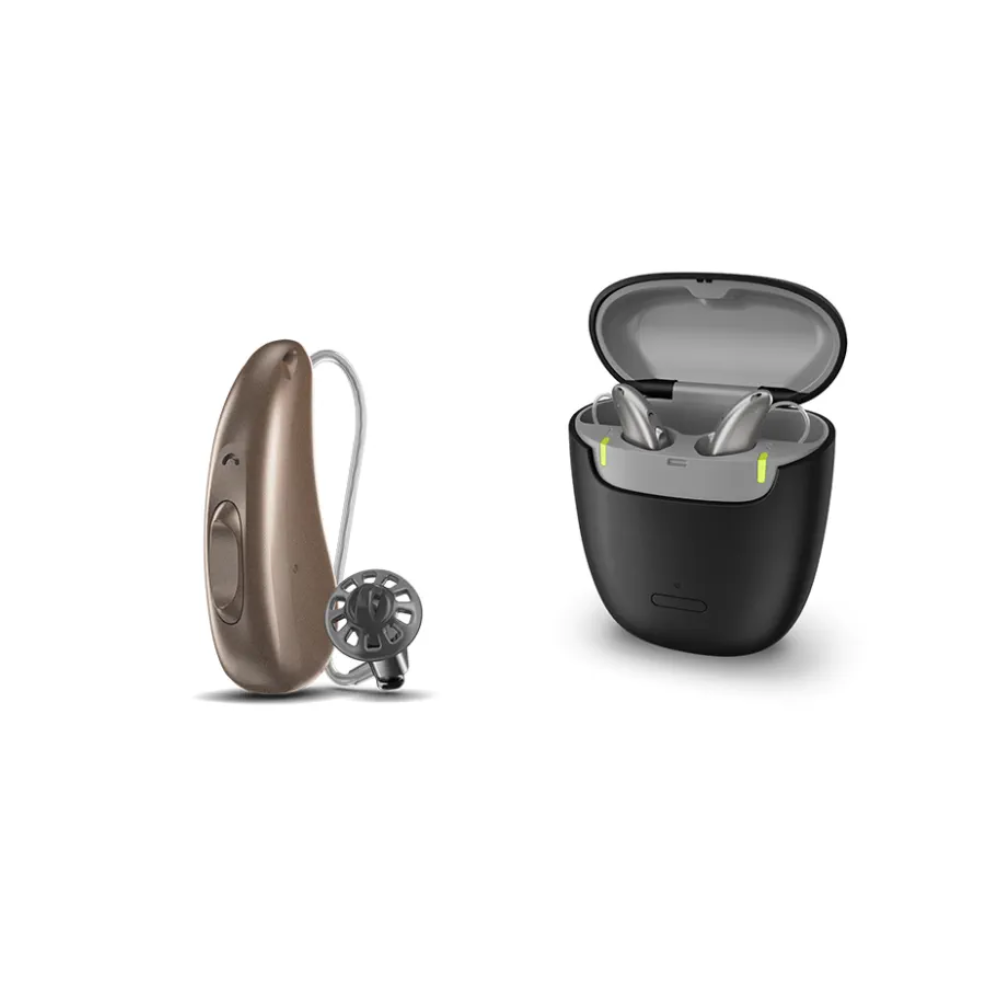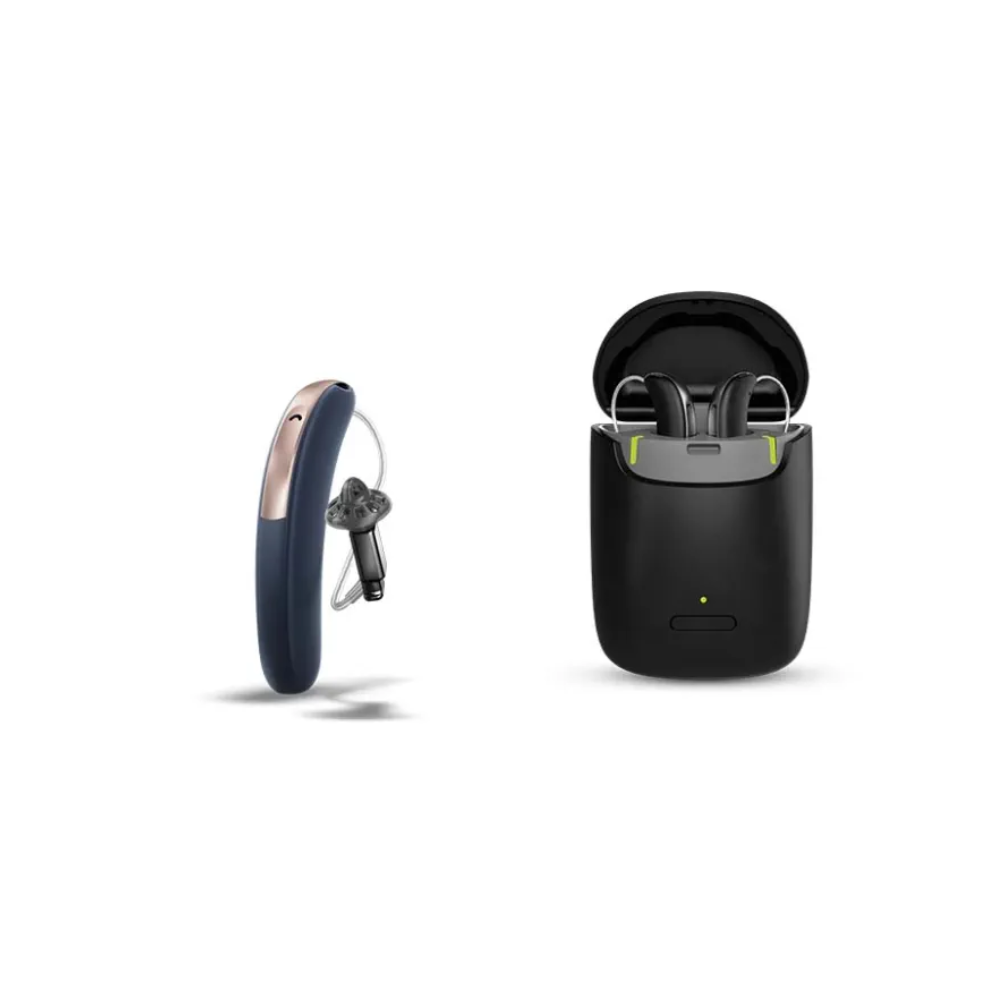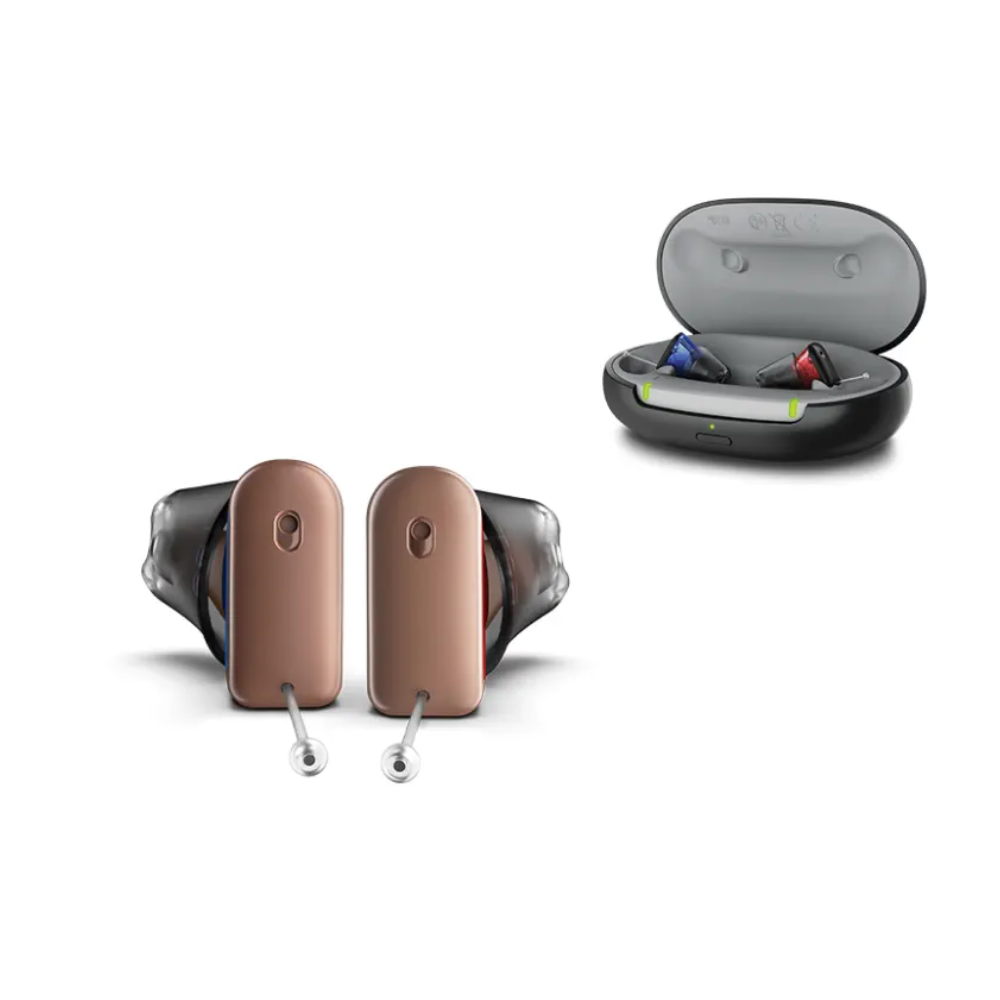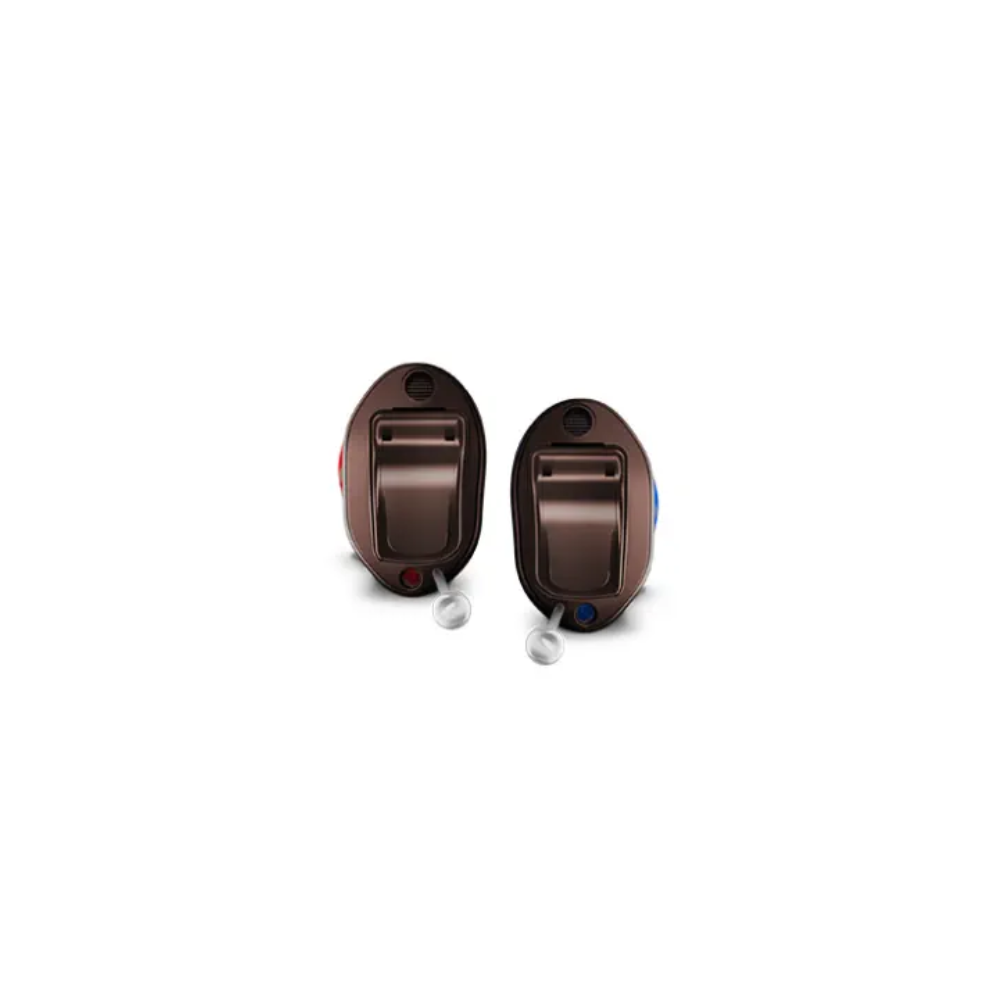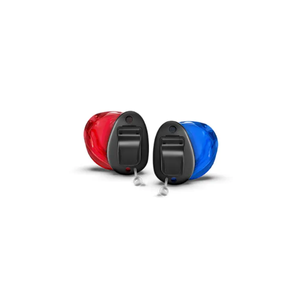Fitting Styles: IIC , CIC , RIC
Warranty: 5 years
Charger: Comes with charger

What's included in our hearing aid prices?
Details & Features
Audio Service 8 G8 Hearing Aids Overview
The Audio Service 8 G8 hearing aids provide reliable performance with clear sound, effective noise reduction, and automatic adjustments for everyday listening. Built on the G8 platform, they support comfortable conversations in a variety of environments.
Offered in both discreet in-the-ear and rechargeable behind-the-ear styles, the 8 G8 models combine practical technology with Bluetooth connectivity and app control, making them a strong mid-level choice for daily hearing support.
Audio Service DIC 8 G8 Introduction
The Audio Service IIC 8 hearing aids are discreet, custom-made devices designed for those who value invisibility without sacrificing performance. Built on the G8 platform, they offer Multi-Track Processing and Auto Optimisation for clear, natural listening in everyday environments.
Small yet powerful, the IIC 8 ensures comfort and ease of use while delivering reliable speech understanding and noise reduction in most listening situations.
IIC 8 Highlights
- Compact, invisible deep-in-canal design
- Multi-Track Processing for adaptive sound clarity
- Speech in Noise and Comfort in Noise features
- Automatic program switching
- Tinnitus therapy options
- Disposable battery-powered
Why Choose IIC 8?
- Ultra-discreet solution for confidence
- Comfortable, custom fit
- Clear, balanced sound for daily life
- Simple, hassle-free handling
Compared to G8 16
The DIC 8 provides excellent daily performance, but misses out on the 16 channels of processing, Spatial Awareness, Multi-Speaker Focus, and advanced UltraZoom beamforming found in the 16-level models. This means slightly less precision in noisy or very complex listening situations.
Audio Service CIC 8 G8 Introduction
The Audio Service CIC 8 (Completely-in-Canal) is a discreet, in-the-ear hearing aid designed for simplicity and performance. Built on the G8 platform, it adapts automatically to different environments using Multi-Track Processing, providing natural sound and comfortable listening throughout the day.
CIC 8 Highlights
- Small, discreet custom fit
- Adaptive sound processing with Multi-Track technology
- Noise reduction and speech enhancement
- Tinnitus therapy included
- Disposable battery
Why Choose CIC 8?
- Discreet, comfortable in-ear option
- Reliable clarity in everyday environments
- Easy to handle and maintain
Compared to G8 16
CIC 8 models lack the extra precision of 16 channels, music optimisation, and advanced environmental features such as Spatial Awareness. As a result, they perform well in daily use but may struggle in noisy or highly dynamic situations compared to CIC 16.
Audio Service IF CIC Li 8 G8 Introduction
The Audio Service IF CIC Li 8 (Invisible-in-Canal, Lithium-Ion rechargeable) combines ultra-discretion with the convenience of rechargeability. Built on the G8 platform, it ensures clear speech and reduced background noise through Multi-Track Processing.
IF CIC Li 8 Highlights
- Invisible in-the-canal fit
- Rechargeable lithium-ion battery
- Multi-Track Processing for balanced sound
- Noise reduction and comfort features
- Tinnitus therapy integrated
Why Choose IF CIC Li 8?
- Invisible design for total discretion
- Rechargeable convenience without disposable batteries
- Adaptive clarity for daily conversations
Compared to G8 16
While effective, the IF CIC Li 8 doesn’t include advanced UltraZoom beamforming, Spatial Awareness, or Multi-Speaker Focus, which help in very noisy environments. It also operates on fewer sound channels, meaning less fine-tuned processing compared to the 16 version.
Audio Service SR Li 8 G8 Introduction
The Audio Service SR Li 8 is a slim, rechargeable receiver-in-canal hearing aid built for convenience and comfort. Using the G8 platform, it automatically adjusts to quiet or noisy environments with Multi-Track Processing for natural sound and speech clarity.
SR Li 8 Highlights
- Slim RIC design with discreet fit
- Rechargeable lithium-ion battery
- Speech enhancement and noise reduction
- Automatic program switching
- Tinnitus therapy options
Why Choose SR Li 8?
- Lightweight, sleek, and comfortable
- Reliable rechargeable performance
- Clear sound in daily listening situations
Compared to G8 16
The SR Li 8 offers strong everyday performance but lacks the extra precision of 16 channels, advanced music optimisation, Spatial Awareness, and enhanced noise management. The 16 delivers a richer, more detailed sound experience, especially in complex listening environments.
Audio Service R Li 8 G8 Introduction
The Audio Service R Li 8 is a rechargeable receiver-in-canal hearing aid designed for those who want great sound, comfort, and connectivity in one sleek package. Powered by the G8 platform, it adapts automatically using Multi-Track Processing, ensuring clarity in most listening environments.
R Li 8 Highlights
- Rechargeable RIC design
- Adaptive Multi-Track Processing
- Speech enhancement and noise reduction
- Music mode and comfort programs
- Tinnitus therapy included
Why Choose R Li 8?
- Discreet, comfortable receiver-in-canal style
- Easy rechargeability
- Clear listening without manual adjustments.
- Models include: R Li T 8
Compared to G8 16
The R Li 8 does not include Multi-Speaker Focus, advanced UltraZoom, or Spatial Awareness, meaning slightly reduced clarity in crowded, noisy environments. It also uses fewer channels, providing less detailed sound analysis than the R Li 16.
Other performance levels in the G8 hearing aid platform:
Need more support with Audio Service 8 G8 hearing aids?
Want to experience these hearing aids for yourself? Call us free on 0800 567 7621 to speak with one of our audiologists.
Please note that there will be an additional surcharge of £125 if we are pairing a single hearing aid with an existing aid bought from another company, where we are taking over the aftercare responsibilities and looking after both hearing aids.
Kimberley Bradshaw started her love of content creation, as a freelancer for many well-established medical brands. She has written about hearing healthcare for several UK and US online health and wellness publications since. Connect with Kimberley on LinkedIn.
Watch the Audioservice Introductory for G8 Hearing aids Video Below
Audioservice G8 Range Brochure
Our specialist service includes:
Do not spend hundreds of pounds without getting a second opinion from us.
Please call us on 0800 567 7621
 Not only are the prices great, but the service is fantastic! Many thanks to your team.
Not only are the prices great, but the service is fantastic! Many thanks to your team.What's included in our hearing aid prices?
FAQs
In general, any audiologist will always recommend to you the hearing aid model that best suits your needs. Here is a useful checklist to make sure that is the case.
- Audiologist's level of knowledge: The audiologist you have seen will hopefully have a wide knowledge of all available hearing aids; however, some will only be familiar with a small number of brands and, therefore, may not really be in a position to know which model is the best for you. It is OK to challenge their recommendation and ask them to justify why this particular brand is the one for you.
- Do research: Read about the hearing aid that was recommended. Does it seem like it will suit your lifestyle? Does it have more or fewer features than you need?
- Be aware of sales targets: Many high street retailers have specific tie-ins to a particular manufacturer/brand. The hearing aid they have suggested may still be the correct one for you, but do your research so that you know why they might have recommended it.
If you have significant hearing loss in both ears, you should be wearing two hearing aids. Here are the audiological reasons why:
Localisation: The brain decodes information from both ears and compares and contrasts them. By analysing the minuscule time delays as well as the difference in the loudness of each sound reaching the ears, the person is able to accurately locate a sound source.
Simply put, if you have better hearing on one side than the other, you can't accurately tell what direction sounds are coming from.
Less amplification is required: A phenomenon known as “binaural summation” means that the hearing aids can be set at a lower and more natural volume setting than if you wore only one hearing aid.
Head shadow effect: High frequencies, the part of your hearing that gives clarity and meaning to speech sounds, cannot bend around your head. Only low frequencies can. Therefore, if someone is talking on your unaided side, you are likely to hear that they are speaking, but be unable to tell what they have said.
Noise reduction: The brain has its own built-in noise reduction, which is only really effective when it is receiving information from both ears. If only one ear is aided, even with the best hearing aid in the world, it will be difficult for you to hear in background noise as your brain is trying to retain all of the sounds (including background noise) rather than filtering them out.
Sound quality: We are designed to hear in stereo. Only hearing from one side sounds a lot less natural to us.
Fancy some further reading on this topic? You can read about why two hearing aids are better than one in our article, hearing aids for Both Ears, here
For most people, the main benefit of a rechargeable hearing aid is simple convenience. We are used to plugging in our phones and other devices overnight for them to charge up. Here are some other pros and cons:
For anybody with poor dexterity or issues with their fingers, having a rechargeable aid makes a huge difference, as normal hearing aid batteries are quite small and some people find them fiddly to change.
One downside is that if you forget to charge your hearing aid, then it is a problem that can't be instantly fixed. For most, a 30-minute charge will get you at least two or three hours of hearing, but if you are the type of person who is likely to forget to plug them in regularly, then you're probably better off with standard batteries.
Rechargeable aids are also a little bit bigger and are only available in Behind-the-Ear models.
Finally, just like with a mobile phone, the amount of charge you get on day one is not going to be the same as you get a few years down the line. Be sure to ask what the policy is with the manufacturer's warranty when it comes to replacing the battery.
For most people, the answer is yes. But it's never that simple.
The majority of hearing problems affect the high frequencies a lot more than the low ones. Therefore, open fitting hearing aids sound a lot more natural and ones that block your ears up can make your own voice sound like you are talking with your head in a bucket. Therefore, in-ear aids tend to be less natural.
However, the true answer is we can't tell until we have had a look in your ears to assess the size of your ear canal, and until we have tested your hearing to see which frequencies are being affected.
People with wider ear canals tend to have more flexibility, also there are open fitting modular CIC hearing aids now that do not block your ears.
There is also the age-old rule to consider, that a hearing aid will not help you if it's sat in the drawer gathering dust. If the only hearing aid you would be happy wearing is one that people can't see, then that's what you should get.
Most people can adapt to any type of hearing aid, as long as they know what to expect. Have an honest conversation with your audiologist as to what your needs are.
Generally speaking, six or more. Unless it's none at all. The number of channels a hearing aid has is often a simplistic way an audiologist will use to explain why one hearing aid is better than another, but channels are complex, and it is really not that straightforward. Here are some reasons why:
Hearing aids amplify sounds of different frequencies by different amounts. Most people have lost more high frequencies than low, and therefore need more amplification in the high frequencies. The range of sounds you hear is split into frequency bands or channels, and the hearing aids are set to provide the right amount of hearing at each frequency level.
Less than six channels, and this cannot be done with much accuracy, so six is the magic number. However, a six-channel aid is typically very basic with few other features and is suitable only for hearing a single speaker in a quiet room. The number of channels is not what you should be looking at; it's more the rest of the technology that comes with them.
As a final note, different manufacturers have different approaches. One method is not necessarily better than any other. For example, some manufacturers have as many as 64 channels in their top aids. Most tend to have between 17 and 20. One manufacturer has no channels at all.
Manufacturer's warranties typically last between 2-5 years, depending on the brand and model, and cover defects in materials and workmanship. This includes repairs for component failures, electronic malfunctions, and manufacturing defects, but excludes damage from misuse, accidents, or normal wear. Most manufacturers also include loss and damage insurance for the first year.
We handle all warranty claims on your behalf, liaising with manufacturers and ensuring you get replacement devices quickly when needed. This comprehensive warranty coverage, combined with our lifetime aftercare, gives you complete peace of mind.
Our hearing tests are completely free, whether at our clinics or in your home. Unlike other providers who charge £30-£100 for home visits, we believe hearing healthcare should be accessible without financial barriers. Our comprehensive assessments include examination by a registered audiologist, audiogram results, and personalised recommendations.
All testing, future adjustments, and ongoing support are included at no extra cost. While NHS tests are also free, typical 6-week waiting periods often lead people to seek immediate private testing. We provide prompt, professional assessments that fit your schedule and budget.
Yes, we offer completely free home visits throughout the UK, and this service is included in our prices with no additional charges. Home visits are particularly valuable for people with mobility issues, busy schedules, or those who simply prefer the comfort and convenience of their own environment.
Our audiologists can conduct full hearing tests, fit hearing aids, and provide ongoing support in your home. This service sets us apart from many providers who either don't offer home visits or charge extra for them.
We can offer prices up to 40% lower than high street retailers because of our business model. As a network of 200+ independent audiologists, we don't have the massive overheads of large retail chains - no expensive high street premises, no sales targets pushing audiologists to sell the most expensive options, and no costly marketing campaigns.
However, we maintain the same buying power as the big chains because we purchase on behalf of our entire nationwide network. This means you get access to the same premium hearing aids with professional service, but at genuinely competitive prices.
We offer a comprehensive 60-day money-back guarantee, which gives you twice the industry standard time to properly assess whether your hearing aids are right for you. This extended period recognises that adjusting to hearing aids takes time, and your brain needs several weeks to adapt to the amplified sounds.
Unlike many providers who offer just 30 days, we believe 60 days gives you the confidence to test your hearing aids in all the situations that matter to you - from quiet conversations at home to busy restaurants and outdoor activities.
Other Models
Ask the Experts
6 Morton Lane
Walkwood
Redditch
Worcestershire
B97 5QA
Latest Launch
When we refer to a product as 'Latest Launch', we mean it is the latest to be released on the market.
New
When we refer to a product as 'New', we mean that the product is the newest hearing aid model on the market.
When we refer to a product as 'Superseded', we mean that there is a newer range available which replaces and improves on this product.
Older Model
When we refer to a product as an 'Older Model', we mean that it is has been superseded by at least two more recent hearing aid ranges.


